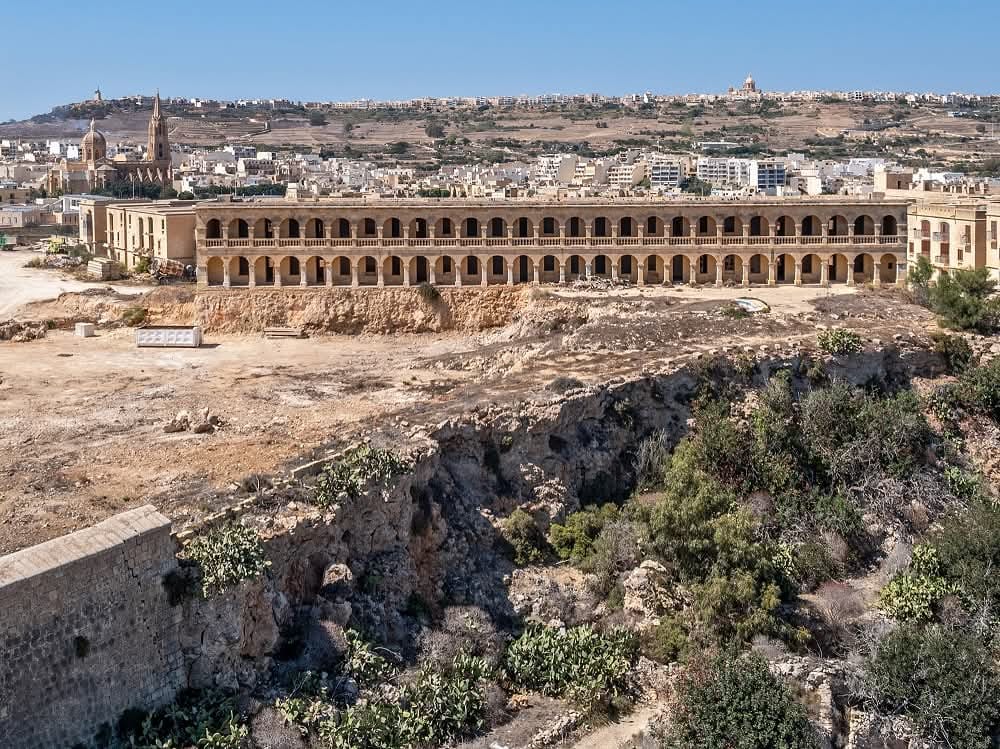On Thursday (today), the Planning Authority (PA) approved plans for a 5-star hotel and 105 residential units to replace parts of Fort Chambray, Gozo.
The proposal, which had already been recommended for approval by the Directorate of Planning, was approved with two votes against and five in favour.
The approval greenlights the development of 105 residential units, based on land spanning 14,514sqm and a five-storey five-star hotel that accommodates 64 rooms and 50 apartments. The project was put forward by developer Michael Caruana on behalf of Fort Chambray Ltd.
Plans indicate that the barracks’ screen and flanks will be relocated to an area closer to the Knights’ barracks while three additional floors will be built over a new building. It will include the re-assembled barrack’s façade.
Planning Board Chairman Emmanuel Camilleri remarked that, in 2012, an outline permit was issued allowing the demolition of the barracks and noted that the Superintendence for Cultural Heritage did not object to the project.
Nonetheless, one of the Board members who voted against the plans, Romano Cassar, described the demolition of the barracks is “an act of madness.” The Gozo Regional Development Authority representative, who was the second member to vote against the project, commented that plans should have been integrated in the project.
The tale of Fort Chambray
Fort Chambray has a rich history that goes beyond its architecture, which dates back to Malta’s era as a fortress island, encompassing decades of controversies.
Fort Chambray lies on a hill, ‘Ras it-Tafal’, in Għajnsielem situated between Mġarr port and Xatt l-Aħmar. It was originally built during the reign of Grand Master Pinto by a Norman Count of the Order of St John, named Francois Chambray.
The initial idea behind the fort was to construct a new town akin to Valletta, replacing the Citadel in the same way that Valletta replaced Mdina as the capital. The Knights believed that its construction would increase the safety, increase commerce between the islands, and attract new populations to Gozo. However, this project was shelved due to a lack of funds. In 1749, Bailiff Jacques Francois de Cahmbray, Lietuenant General of the Ships, was appointed Governor of Gozo and offered to finance the fortifications’ construction. By 1770, Fort Chambray was built but the idea of building a town around it never materialised.
During the 20th century, specifically during the First World War the British built barracks within the walls. In 1934, the Government started using it as a mental institution and in World Ward II it was used as a hospital,
Later, the Nationalist Government introduced plans to develop it into a tourism establishment, including a 320-bed hotel. However, in 1971, a Labour Government scrapped plans and had refurbished the mental hospital. In 1979, patients were moved elsewhere and the fort was allocated for tourism. Little development occurred but interestingly, in 1987, Labour Party activities took place in the area ahead of the election. Additionally, pre-election, the Government transferred the fort to the Zammit Tabona family, who headed Fort Holidays.
In 1993, the land was granted to an Italian businessman Roberto Memmo on a 99-year lease, however questions arose as to how this transfer took place. In 1998, Joseph Muscat – who would eventually become Prime Minister – had written a book about the alleged irregularities that took place surrounding the concession.
The businessman had plans to turn the barracks into a hotel with 236 residential units and render it a commercial centre. However, the plan was cut short when the Government terminated the agreement and transferred the land to Michael Caruana in 2005 for around Lm3.7 million, a value of approximately €8.6 million.
Mr Caruana’s lease was granted for 87 years and was set to expire in April 2092. He had told Times of Malta that he wanted to transform Fort Chambray into “an internationally renowned landmark.” However, former Minister Austin Gatt had remarked that the developers would be facing a Lm100 fine every day if they did not keep up with the timelines and that Government had the right to dissolve the contract.
Since then, the barracks have remained in place, teetering on the edge of structural failure until last year when two planning applications were filed to demolish the apartments and construct a hotel and more apartments.
A Parliamentary committee met, with Minister Stefan Zrinzo Azzopardi stated that some construction works begun years earlier, but remained unfinished and restoration works on part of its historical structures were also carried out, but fortifications required “urgent intervention.”
The committee then unanimously agreed to amend the concession allowing parts of the site to be transferred to new investors. This means that Mr Caruana can sell the concession to a group of investors.
Minister Zrinzo Azzopardi remarked that the amendment would clarify how the development will be carried out and how fortifications will be restored. Additionally, he said that there will be clearer obligations for the building of the hotel, which will need to be completed within 48 months of a development permit being granted.
Featured Image:
Fort Chambray / Facebook
EU Funding Helpdesk launched as one-stop-shop for business opportunities
The Helpdesk aims to support businesses in their pursuit of local and EU funding opportunities
Final deeds of sale rise 8.4%, promise of sale agreements up 6.8% in November
Malta’s residential property market strengthened again last month
Employment rises 4.8% as labour market continues to expand
66.8% of the population aged 15 and above are employed






